
Atlas F1 Technical Writer
The new layout of the Nurbrugring presented several challenges to the teams, in last weekend's European Grand Prix. Tyres, aerodynamics, power - all were put to the test. Some came out the winners, some came out the losers. Craig Scarborough reviews the cars and their performance
Revisions to the layout of the Nurburgring track provided the teams with plenty of headaches. The new layout put a much larger emphasis on downforce and mechanical grip in the slower corners than the teams were prepared for, and tyre performance affected all the teams more than expected. It would be fair to say that Michelin won qualifying, but the soft compound they ran for the three-lap runs could not last the distance in the race, which placed Ferrari on Bridgestones at a great advantage.
Changes to the track altered the first sequence of corners, and going down the long main straight the cars had to brake into a very tight right-hand hairpin. The exit of the corner opened up to provide the drivers with one of two lines into the following left-handed bend, nevertheless the most common line was to take a wide exit before sweeping back in for the approaching corner. In fact, the alternative line was a much tighter exit, driving straight toward the turn-in point the following corner.
When matched to the late braking into turn one, the layout provided a real overtaking opportunity and was a classic example of what many drivers have asked for in Grand Prix circuits. However, the strange camber on the track around the corner - lifting the inside front wheel and the high inside kerb - made the first corner tricky to negotiate. It was here in the race that Williams's Juan Pablo Montoya came to blows with David Coulthard's McLaren.
Bumps on the entry to many of the corners tested the suspension set-up, and many cars either locked up or spun off on entry to these corners. It was the Veedol chicane that was the common place for indiscretions in the race, as the cars ended up running wide over the high kerb and onto the grass.
Braking into the first corner, where the cars are braking from top speed, also caused wear on the plank. At high speed the nose of the car is pressed towards the ground by the aerodynamic downforce, then as the car brakes the weight shifts forward and the nose dives even further, leading to the front edge of the plank impacting the ground. Brown marks left by the plank on the track 100 metres from the corner testify to this grounding. Nevertheless, and surprisingly enough, there were no problems in scrutineering from worn planks caused by damage from these excursions.
Tyres
It has been commonly agreed that Michelin makes a better hard tyre, which lasts well even when the grooves are worn down. It is also agreed that their tyres work better in hot temperatures. Looking at the evidence from recent races - such as Monaco, Canada and the Nurburgring - the situation seems to have shifted to the opposite.
Michelin are producing a much softer tyre, giving their teams such benefits as three pole positions from Juan Pablo Montoya. But each race has seen the Michelin runners suffer - the rear tyres especially wearing down past the grooves and giving up their performance. In the European Grand Prix, Montoya's rear tyres were clearly worn down to slicks, long before his scheduled pitstop. While in theory slick tyres give more grip than the smaller surface area of grooved tyres, in reality if the tyre compound has been worn out then the rubber has no grip to offer whatsoever. Hence, as the coming races are all due to be in the heat of the European summer, Michelin need to reappraise their choice of compounds.
Team by Team
Ferrari
Ferrari came to the track expecting a tough fight, and practice and qualifying proved their fears right. However, the Bridgestone tyres and the two-stop strategy they deployed in the race eclipsed the other teams and saw both cars running flat out and in close company for the entirety of the race.
The engine cover serves to streamline the rollover structure and fair in the airbox, to prevent teams making these covers very long and streamlined, as seen in CART. The rules specify a triangle in front of the rear wing in which no body work can be present, and this also prevents extra wings being placed in this area. As a result of this hard geometric rule, most teams adopt an engine cover shape that extends up to the triangle area, and the trailing edge of the engine cover forms a perfect straight line leading down towards the rear of the car.
Seeing that modern engines are allowing airboxes to be placed lower, the possibility to improve flow to the rear wing with a lower cover hasn't been explored, until Ferrari tried this new layout.
Ferrari also debuted their new Magneti Marelli telemetry system, exploiting the rules that now allow two-way data exchange between the car and pits. It is at first strange that Ferrari have left this system off the car for so long, when Williams and McLaren have been openly using theirs since the start of the season. But with Ferrari's dominance, the risk of adopting a new system too early outweighed any benefits.
Qualifying created problems for the team, when Michael Schumacher's race car suffered a transmission problem, causing him to get stuck in gear on his outlap, and he had to slowly return to the pits. The floor was removed as the mechanics worked on the car, and Schumacher jumped into the spare, which did not have the same updates as his race car. He took several runs to set the car up to his liking, but a mistake in the last corner spoilt his run.
As expected, Rubens Barrichello was back on form in this race, however before that, in qualifying, he was not happy with the feel of the car and worked during the session to improve the car, but not enough to outrun the Williams.
A strong run in the warm up gave a signal that the team were fast and would probably be on the theoretically faster two-stop strategy - all they had to do is pass the two Williamses at the start. And indeed, the lighter fuel load gave the two Ferrari drivers the chance to pass the cars and make a break for their early first stop.
Within a few laps their advantage was clear. However, coming up to the first round of stops, Schumacher was pushing Barrichello hard, knowing he might be able to pass him 'risk free' in the pits, and he overshot the corner and spun. Fortunately, this was one of the new tarmac run off areas and thus Schumacher was able to rejoin the race ten seconds down. Thereafter the race ran smoothly for the team, who brought the cars home in first and second.
Williams
As with most teams, Williams struggled to dial the car into the altered track and spent much of Friday slowly improving the car and assessing tyres. For qualifying, most believed Montoya was the only person to string together a perfect lap - he avoided overdriving and messing up the line through the chicane and was aided by the softer Michelins to take pole from his teammate, who was on the harder option tyres.
Before the race, Montoya suffered an engine problem in the warm-up and gave rise to doubts over the reliability of the revised BMW engine.
With the drivers on split tyre choices, it was surprising they opted for the same strategy in the race. Montoya started on scrubbed soft tyres while Ralf was able to get a better start with new rear tyres despite the harder compound. But this was the only point the tyres were a benefit, as the rear tyres wore out rapidly, leaving the drivers with almost undriveable cars. Ralf was called in for an earlier pitstop than planned to replace his worn tyres, whereas Montoya already retired following his incident with Coulthard.
McLaren
With McLaren fastest in the Friday sessions and with a smaller gap to pole in qualifying, McLaren were happy with progress, and as there were no problems on the cars, both drivers developed their set ups over the two days.
Good starts from both drivers gave shine to a much better race performance than expected from McLaren on Michelins, and they suffered less of the tyre degradation that Williams suffered. Moreover, the McLaren drivers were pushing the Williams drivers thoughout the first stint, and with Coulthard taken out by Montoya, it was left to Raikkonen to pass Ralf Schumacher. The Finn was fighting Ralf at half way, and when Ralf's pitstop was called early, Raikkonen was able to run the extra laps to open the gap and bring the car home in a reliable third position.
Renault
The team again appeared with the delta rear wing brought to Monaco. This wing places two curves in the rear element to form the shape, and the main flap then has thinner outer sections. There was also a new traction control system that better integrated the control of the engine, clutch, gearbox and differential.
The team backed up their fourth place in the Constructors Championship with a strong qualifying performance, the car seeming to be suited well to the track.
Sauber
Despite no new parts on the car, Sauber benefited from the Bridgestone tyres in the race, after problem-free sessions on Friday and in Qualifying. The cars ran strongly and in close company in the race to finish with one car in the points and the other right behind.
Jordan
After the optimism of the recent races, the Nurburgring was a retrograde race for the team. They struggled with the set up all weekend and couldn't get the car to suit the revised track. Qualifying was a disaster, with both drivers down the field. And, even after making suspension adjustments in the session to rid the car of understeer, Giancarlo Fisichella posted his worst qualifying slot since Silverstone last year.
In the race, while trying to make up for the poor qualifying performance, Fisichella spun into turn one and hit his teammate Takuma Sato, and while both cars were able to continue, Fisichella damaged his sidepod and suspension - the tear in the sidepod flapped on the main straight. Soon chunks of carbon fibre bodywork were ripped off by the airflow and were deposited all over the main straight. Fisichella eventually retired in the pit garage, describing the car as "undriveable after the incident," Sato on the other hand continued after a pitstop but never caught up with the field and had a lonely drive to the finish.
BAR
In the race the pattern continued: Panis worked his way up to 9th with a one-stop strategy and Villeneuve had engine troubles limiting his pace, which meant he had to work hard to get to 12th by the end of the race.
Jaguar
It has been the same story for Jaguar all season: the car isn't working well and it is only hard work and luck that at times bring results. This race proved no different - the cars, still externally unchanged, struggled throughout but maintained their place at the back of the midfield. Pedro de la Rosa found his car better suited to the track and outperformed Eddie Irvine all weekend. And, in the race a hydraulic failure ended Irvine's race while de la Rosa came home in eleventh.
Arrows
Unsure whether the revised track would suit the car, Arrows found the high-speed section of the Nurburgring to be a struggle. Enrique Bernoldi suffered more than Heinz Harald Frentzen, and an off-track moment that led to some damage to the car interrupted his set up work.
Neither driver had the set-up they wanted for qualifying, and again Bernoldi came off worse. Nevertheless, the Brazilian made up for it in the race, jumping from 21st to 14th at the start and despite making a mistake and letting his teammate back through, Bernoldi drove a charging race - even passing a Jaguar on the last lap.
Frentzen had yet more troubles with his fuel rig, dropping him behind his teammate, but nonetheless made it to the finish.
Toyota
Although having tested at the circuit last year, Toyota effectively had to relearn the track - such are the changes to the Nurburgring. The team's test before the race paid off, as the car's performance over the bumps and kerbs was much improved. Neither driver had any real problems with the track, and although there were some undisclosed electronics problems, the results in qualifying showed the car's current potential.
Mika Salo slowed at the start of the race and fell to the back of the field, which compromised the one-stop strategy he was running. Allan McNish had a better start and fought his position until he started to fade and dropped several positions. His first pitstop was long due to a problem changing his front wheel. He then started to have shoulder problems from his seat and his lap times fell until he finished a painful and exhausting fourteenth. Salo at the same time tailed near the end of the field until he retired with a suspected gearbox failure on lap 55.
Minardi
With the good news that they will receive the extra TV money from the FOA, Minardi can look forward to the rest of the season. However, the European Grand Prix was another typical race for Minardi - no major problems coupled with sound reliability over the first two days.
Alex Yoong enjoyed a steadier weekend than his previous ones, but trailed the field in qualifying and retired a few laps from the end of the race with a failed hydraulic pump.
Mark Webber outpaced two drivers to qualify in 20th, but during the race had tyre problems that were upsetting the car's handling in his first stint. This was resolved after the first pitstop and he managed to finish the race.
The season has now reached the halfway point, with nine races run and eight to go. Ferrari's dominance made many of the race results predictable this year, however it is the lack of consistencing in the performance of the trailing teams that continues to puzzle.
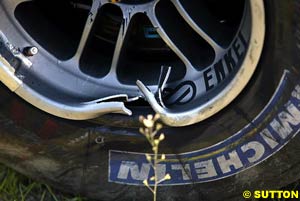 Coulthard got a better run out of the final corner and out-braked Montoya on the outside into the first corner. The Scot left some space, but Montoya took a very tight line, clipped his rear wheel on the kerb and spun - his right rear wheel hitting Coulthard's front left. Subsequently, the toe link on Montoya's car was broken and hung uselessly from the rear upright (see picture), and Coulthard's front lower wishbone was broken and the wheel was unsteerable, forcing him to park his car.
Coulthard got a better run out of the final corner and out-braked Montoya on the outside into the first corner. The Scot left some space, but Montoya took a very tight line, clipped his rear wheel on the kerb and spun - his right rear wheel hitting Coulthard's front left. Subsequently, the toe link on Montoya's car was broken and hung uselessly from the rear upright (see picture), and Coulthard's front lower wishbone was broken and the wheel was unsteerable, forcing him to park his car.
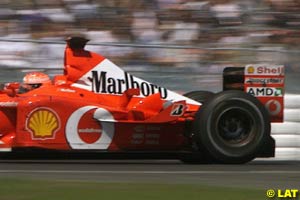 Friday went cleanly for the team, the usual process of checking what tyre to use and set-up was complicated by the evaluation of new aerodynamic parts for this race. A new engine cover was brought to Germany, which is lower than the older version. In fact, the new cover swoops down after the roll hoop and actually cuts off the tops of the letters on the Marlboro logo.
Friday went cleanly for the team, the usual process of checking what tyre to use and set-up was complicated by the evaluation of new aerodynamic parts for this race. A new engine cover was brought to Germany, which is lower than the older version. In fact, the new cover swoops down after the roll hoop and actually cuts off the tops of the letters on the Marlboro logo.
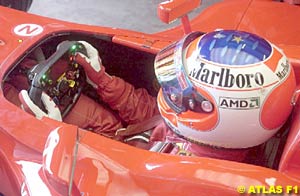 Along with the new electronics there is also a new steering wheel - the famous Ferrari format wheel has been revised for a slimmer design, with less buttons, and there is now a larger display screen. Moreover, some buttons have been replaced by two large multi-function rotary switches.
Along with the new electronics there is also a new steering wheel - the famous Ferrari format wheel has been revised for a slimmer design, with less buttons, and there is now a larger display screen. Moreover, some buttons have been replaced by two large multi-function rotary switches.
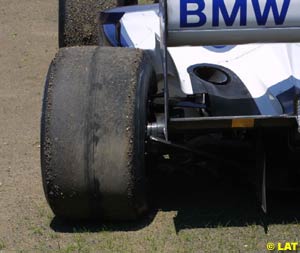 There was yet another revision to the sidepods of the FW24 for this race, as Williams went backwards to use a design from last year. The large flip up is now joined to the sidepod all the way along its length, including the vertical portion of the flip up between the rear wheels. A small panel was added to fill in the gap between the vertical section and the narrow part of the sidepod, and this layout appeared on the Williams in 2001 until the United States GP late in the year.
There was yet another revision to the sidepods of the FW24 for this race, as Williams went backwards to use a design from last year. The large flip up is now joined to the sidepod all the way along its length, including the vertical portion of the flip up between the rear wheels. A small panel was added to fill in the gap between the vertical section and the narrow part of the sidepod, and this layout appeared on the Williams in 2001 until the United States GP late in the year.
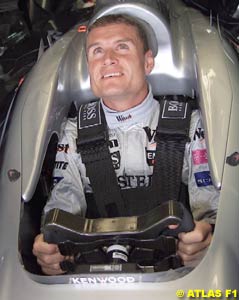 There was only one tiny noticeable change to the McLaren cars, and that was the new moulded steering wheel which Coulthard adopted, although it was in fact used since the start of the season by Kimi Raikkonen.
There was only one tiny noticeable change to the McLaren cars, and that was the new moulded steering wheel which Coulthard adopted, although it was in fact used since the start of the season by Kimi Raikkonen.
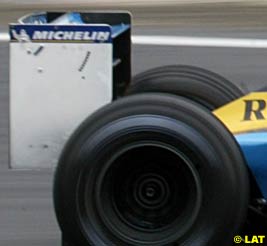 In the race, however, Jarno Trulli suffered an intermittent engine problem - although the car remained reliable even if a little off the pace. Jenson Button meanwhile had a better start and no problems, save for tyre degradation, to finish fifth and complete a rare two-car finish for the team.
In the race, however, Jarno Trulli suffered an intermittent engine problem - although the car remained reliable even if a little off the pace. Jenson Button meanwhile had a better start and no problems, save for tyre degradation, to finish fifth and complete a rare two-car finish for the team.
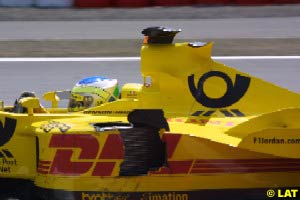 Bringing the new aero package and the long awaited qualifying engine from Honda, the team hoped for a good weekend. Friday started well with both drivers comfortable with the car and Olivier Panish outpacing Jacques Villeneuve. However, the new engine did not pay dividends in qualifying, as the chassis was struggling for pace. Panis worked hard to get 12th place on the grid, but Villeneuve was way off on his set up and ended up in 19th, stating the newly built monocoque might have played a part in the troubles.
Bringing the new aero package and the long awaited qualifying engine from Honda, the team hoped for a good weekend. Friday started well with both drivers comfortable with the car and Olivier Panish outpacing Jacques Villeneuve. However, the new engine did not pay dividends in qualifying, as the chassis was struggling for pace. Panis worked hard to get 12th place on the grid, but Villeneuve was way off on his set up and ended up in 19th, stating the newly built monocoque might have played a part in the troubles.
Please Contact Us for permission to republish this or any other material from Atlas F1.
|
Volume 8, Issue 26
Articles
2002 Rookie Review
Ann Bradshaw: View from the Paddock
Jo Ramirez: a Racing Man
European GP Review
European GP Review
European GP - Technical Review
The Rope, the Tree & the Prancing Horse
Audi: Out of it?
Stats Center
Qualifying Differentials
SuperStats
Charts Center
Columns
Season Strokes
Elsewhere in Racing
The Grapevine
> Homepage |